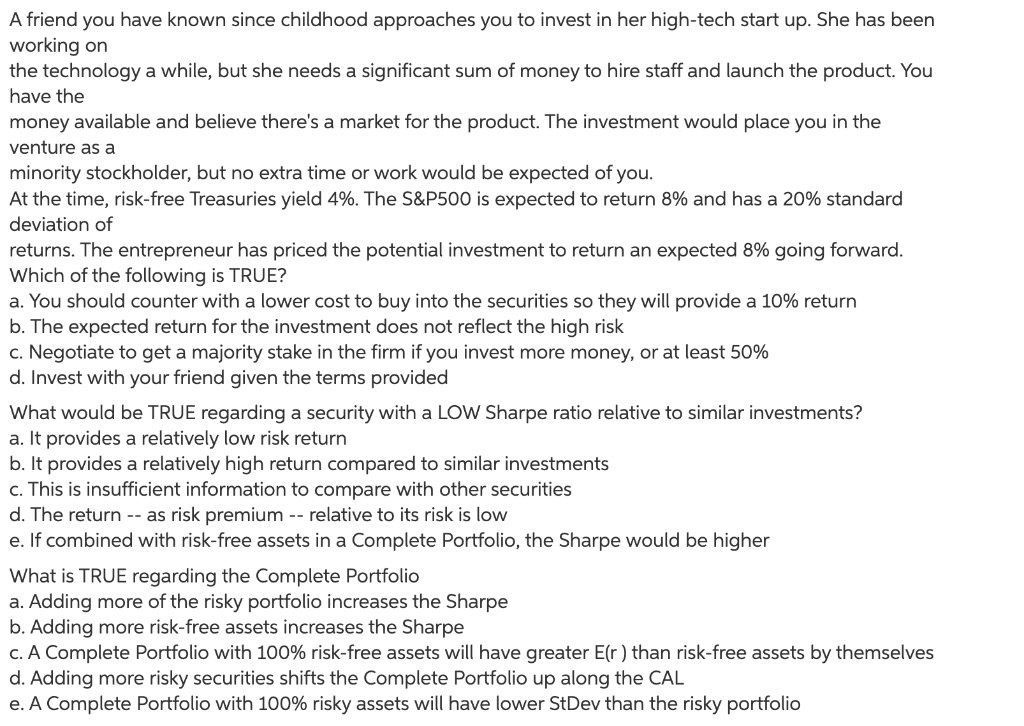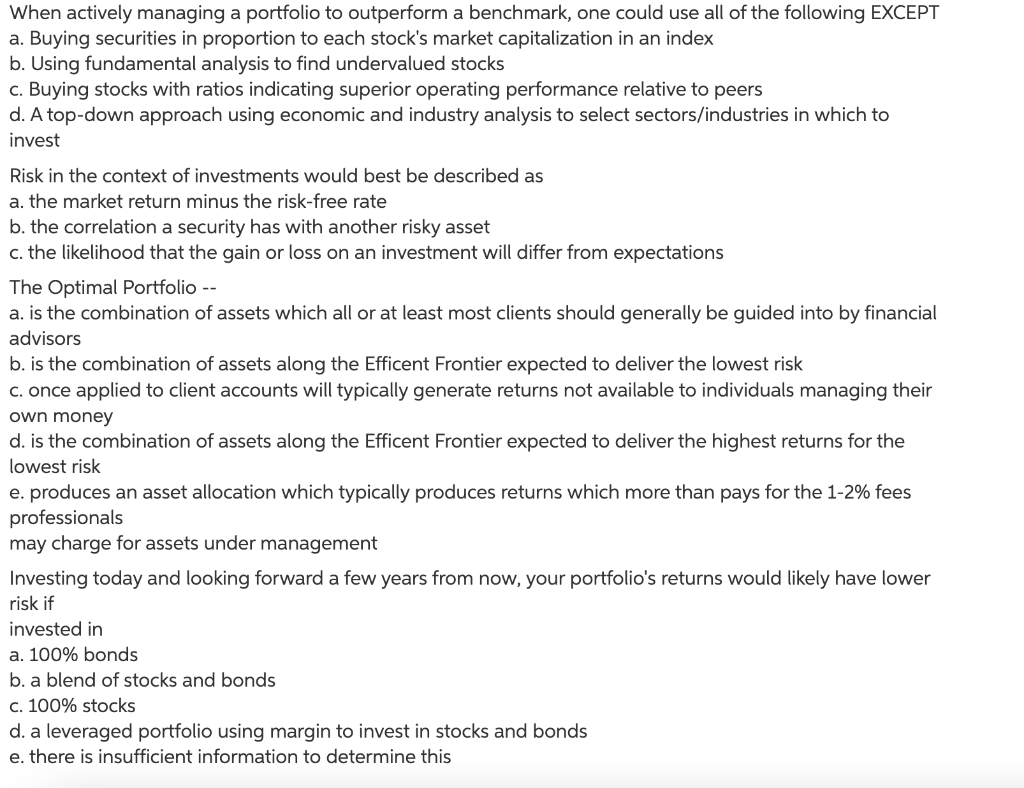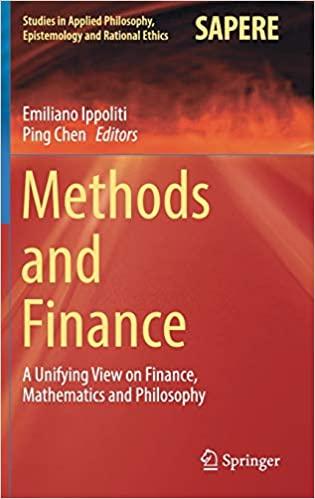

A friend you have known since childhood approaches you to invest in her high-tech start up. She has been working on the technology a while, but she needs a significant sum of money to hire staff and launch the product. You have the money available and believe there's a market for the product. The investment would place you in the venture as a minority stockholder, but no extra time or work would be expected of you. At the time, risk-free Treasuries yield 4%. The S&P500 is expected to return 8% and has a 20% standard deviation of returns. The entrepreneur has priced the potential investment to return an expected 8% going forward. Which of the following is TRUE? a. You should counter with a lower cost to buy into the securities so they will provide a 10% return b. The expected return for the investment does not reflect the high risk c. Negotiate to get a majority stake in the firm if you invest more money, or at least 50% d. Invest with your friend given the terms provided What would be TRUE regarding a security with a LOW Sharpe ratio relative to similar investments? a. It provides a relatively low risk return b. It provides a relatively high return compared to similar investments c. This is insufficient information to compare with other securities d. The return -- as risk premium -- relative to its risk is low e. If combined with risk-free assets in a Complete Portfolio, the Sharpe would be higher What is TRUE regarding the Complete Portfolio a. Adding more of the risky portfolio increases the Sharpe b. Adding more risk-free assets increases the Sharpe c. A Complete Portfolio with 100% risk-free assets will have greater E(r) than risk-free assets by themselves d. Adding more risky securities shifts the Complete Portfolio up along the CAL e. A Complete Portfolio with 100% risky assets will have lower StDev than the risky portfolio When actively managing a portfolio to outperform a benchmark, one could use all of the following EXCEPT a. Buying securities in proportion to each stock's market capitalization in an index b. Using fundamental analysis to find undervalued stocks c. Buying stocks with ratios indicating superior operating performance relative to peers d. A top-down approach using economic and industry analysis to select sectors/industries in which to invest Risk in the context of investments would best be described as a. the market return minus the risk-free rate b. the correlation a security has with another risky asset c. the likelihood that the gain or loss on an investment will differ from expectations The Optimal Portfolio -- a. is the combination of assets which all or at least most clients should generally be guided into by financial advisors b. is the combination of assets along the Efficent Frontier expected to deliver the lowest risk c. once applied to client accounts will typically generate returns not available to individuals managing their own money d. is the combination of assets along the Efficent Frontier expected to deliver the highest returns for the lowest risk e. produces an asset allocation which typically produces returns which more than pays for the 1-2% fees professionals may charge for assets under management Investing today and looking forward a few years from now, your portfolio's returns would likely have lower risk if invested in a. 100% bonds b. a blend of stocks and bonds c. 100% stocks d. a leveraged portfolio using margin to invest in stocks and bonds e. there is insufficient information to determine this A friend you have known since childhood approaches you to invest in her high-tech start up. She has been working on the technology a while, but she needs a significant sum of money to hire staff and launch the product. You have the money available and believe there's a market for the product. The investment would place you in the venture as a minority stockholder, but no extra time or work would be expected of you. At the time, risk-free Treasuries yield 4%. The S&P500 is expected to return 8% and has a 20% standard deviation of returns. The entrepreneur has priced the potential investment to return an expected 8% going forward. Which of the following is TRUE? a. You should counter with a lower cost to buy into the securities so they will provide a 10% return b. The expected return for the investment does not reflect the high risk c. Negotiate to get a majority stake in the firm if you invest more money, or at least 50% d. Invest with your friend given the terms provided What would be TRUE regarding a security with a LOW Sharpe ratio relative to similar investments? a. It provides a relatively low risk return b. It provides a relatively high return compared to similar investments c. This is insufficient information to compare with other securities d. The return -- as risk premium -- relative to its risk is low e. If combined with risk-free assets in a Complete Portfolio, the Sharpe would be higher What is TRUE regarding the Complete Portfolio a. Adding more of the risky portfolio increases the Sharpe b. Adding more risk-free assets increases the Sharpe c. A Complete Portfolio with 100% risk-free assets will have greater E(r) than risk-free assets by themselves d. Adding more risky securities shifts the Complete Portfolio up along the CAL e. A Complete Portfolio with 100% risky assets will have lower StDev than the risky portfolio When actively managing a portfolio to outperform a benchmark, one could use all of the following EXCEPT a. Buying securities in proportion to each stock's market capitalization in an index b. Using fundamental analysis to find undervalued stocks c. Buying stocks with ratios indicating superior operating performance relative to peers d. A top-down approach using economic and industry analysis to select sectors/industries in which to invest Risk in the context of investments would best be described as a. the market return minus the risk-free rate b. the correlation a security has with another risky asset c. the likelihood that the gain or loss on an investment will differ from expectations The Optimal Portfolio -- a. is the combination of assets which all or at least most clients should generally be guided into by financial advisors b. is the combination of assets along the Efficent Frontier expected to deliver the lowest risk c. once applied to client accounts will typically generate returns not available to individuals managing their own money d. is the combination of assets along the Efficent Frontier expected to deliver the highest returns for the lowest risk e. produces an asset allocation which typically produces returns which more than pays for the 1-2% fees professionals may charge for assets under management Investing today and looking forward a few years from now, your portfolio's returns would likely have lower risk if invested in a. 100% bonds b. a blend of stocks and bonds c. 100% stocks d. a leveraged portfolio using margin to invest in stocks and bonds e. there is insufficient information to determine this








